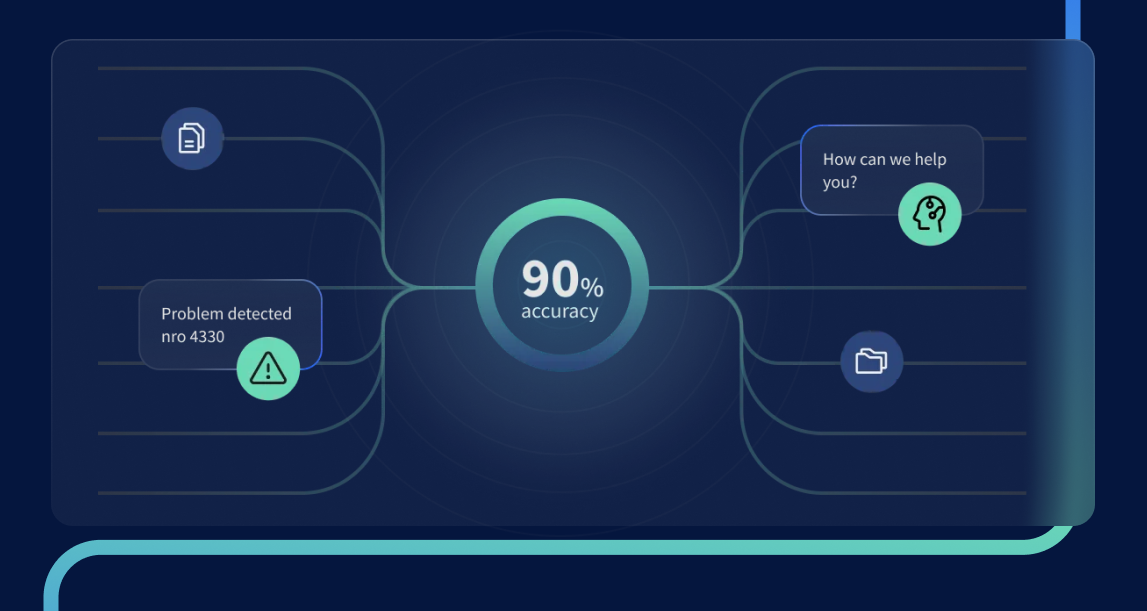Neuron7 Unveils New Intelligence Layer

While the market is all abuzz with new agentic AI solutions, service leaders face a harsh reality: 95% of enterprise AI pilots fail to reach production. Which means, despite billions invested in AI initiatives, only 5% of organizations achieve lasting value from their AI deployments.
Today, Neuron7 changes that with the launch of a Unified Intelligence Layer, the next evolution of our proven Smart Resolution Hub that transforms how service organizations deploy AI successfully.
The Foundation That Changed Everything
Five years ago, Neuron7 pioneered the Smart Resolution Hub, the first AI platform built specifically for service organizations. While others focused on generic search or chatbots, we solved the fundamental challenge that plagued service AI: how to process and understand heterogeneous (i.e. messy and complex) service datasets.
The Smart Resolution Hub broke new ground by enabling service organizations to achieve what seemed impossible: Unmatched resolution accuracy from AI-guided workflows.

Why Current Agentic AI Announcements Miss the Mark
The current wave of agentic AI launches reveals a fundamental misunderstanding of service AI requirements. Recent launches all promise revolutionary automation. All lack the foundational intelligence layer that service operations demand.
Current Agentic solutions built on LLMs and basic RAG systems can't handle the complexity of real-world service environments. They struggle with:
- Domain-specificity: An organization may deploy a broad set of personalized search capabilities that promises contextual and personalized search, but how is one model going to understand the nuances of service when it needs to know sales, marketing, etc. It’s no surprise that Gartner states over 50% of AI models in 2027 will be domain specific.
- Data Integration Chaos: For example, a support agent dealing with a network outage receives conflicting information from three different systems. One shows "normal operations," the customer's device logs indicate connection failures, and the CRM shows similar complaints from the same region. Generic agents are going to run off and gather limited content and completely misidentify that a local fiber cut is the root cause.
- Context-Free Responses: When a field service technician asks about replacing a failing HVAC compressor, generic AI suggests ordering a standard part without understanding that replacing just the compressor without addressing the underlying electrical issue will cause the same failure within weeks. The impact? More parts wastage, and a callback.
- Trust Gaps: A technical support engineer troubleshooting an outage gets an AI recommendation to "restart the primary controller." But the AI doesn't indicate its confidence level or provide a detailed step-by-step diagnostic and resolution. Without confident guidance, technicians can't trust critical recommendations.
The statistics confirm the failure: 42% of companies abandoned most AI initiatives in 2024, up from just 17% in 2023.

Introducing the Intelligence Layer
Building on years of proven success with the Smart Resolution Hub, we're launching the Intelligence Layer, a comprehensive service AI foundation that combines best of breed AI capabilities into a unified intelligence layer designed specifically for complex service environments.
This isn't another collection of AI agents. It's the evolutionary leap that transforms the Smart Resolution Hub from a knowledge platform into a complete service intelligence ecosystem.
Four Revolutionary Capabilities, One Intelligent Foundation
The Intelligence Layer launches with four integrated capabilities that extend the Smart Resolution Hub into complete service transformation:
- Resolution Pathways 2.0: An evolution of Neuron7’s pioneering guided resolution technology. New UX features, including enhanced mobile optimization, make it easier for service teams to resolve complex issues accurately and reduce reliance on senior engineers.
- Service Insights: Transforms your service data foundation into strategic intelligence. It aggregates patterns across customer interactions into actionable business insights like which techs or agents are most successful with specific routines, which issues consume the most parts, and other actionable service insights previously hidden in service data.
- Log Analyzer: Leverages the Smart Resolution Hub's heterogeneous data processing to convert chaotic device logs and error messages into actionable service insights. Tools like Splunk weren’t built for service teams, so Log Analyzer was purpose-built to reduce the time it takes to transform and translate logs, getting you to Root Cause quicker.
- Predictive Maintenance Intelligence: Combines the Smart Resolution Hub's structured and unstructured data mastery with predictive capabilities. Transform from reactive firefighting to proactive optimization with asset predictions that reduce repeat visits and extend equipment performance.
Real Results from Real Foundations
Organizations building on the Smart Resolution Hub foundation report transformative outcomes:
- NCR Atleos: 92% AI answer accuracy, 50% reduction in support cases, 13% reduction in service revisits
- Ciena: 14-point customer satisfaction increase, 46% faster resolutions, 50% call deflection improvement
- Terumo BCT: 13% increase in resolutions without parts, 20% deflected escalations, 24% decrease in average part cost per escalated work order
These aren't experimental results. They are production outcomes from organizations that chose proven service intelligence over generic AI experiments.

The Competitive Advantage That Compounds
Organizations deploying the Intelligence Layer don't just get better AI. They build service intelligence that becomes a sustainable competitive advantage over time. Specifically it helps with:
- Knowledge Feedback Loops: Every resolution builds living organizational knowledge that makes future resolutions faster and more accurate
- Pattern Recognition: Cross-case learning identifies optimization opportunities invisible to traditional analytics
- Strategic Intelligence: Transform service operations from cost centers into strategic differentiators. Imagine the ability to confidently collaborate and deliver better product
Next Steps: Evolve Your Service AI Strategy
Service leaders choosing the Intelligence Layer aren't adopting new technology. They're completing their service AI evolution with capabilities that build on proven foundations rather than experimental approaches.
The question isn't whether to deploy service AI. It's whether to build on solid foundations designed to guarantee success in complex service environments, or experiment with approaches that contribute to the 95% failure rate.
Complete Your Service AI Evolution
Explore The Ultimate Guide to AI for Complex Service and see how the right Intelligence Layer can help you scale resolution, not risk.
Discover how Neuron7 works in your service environment.




.png)